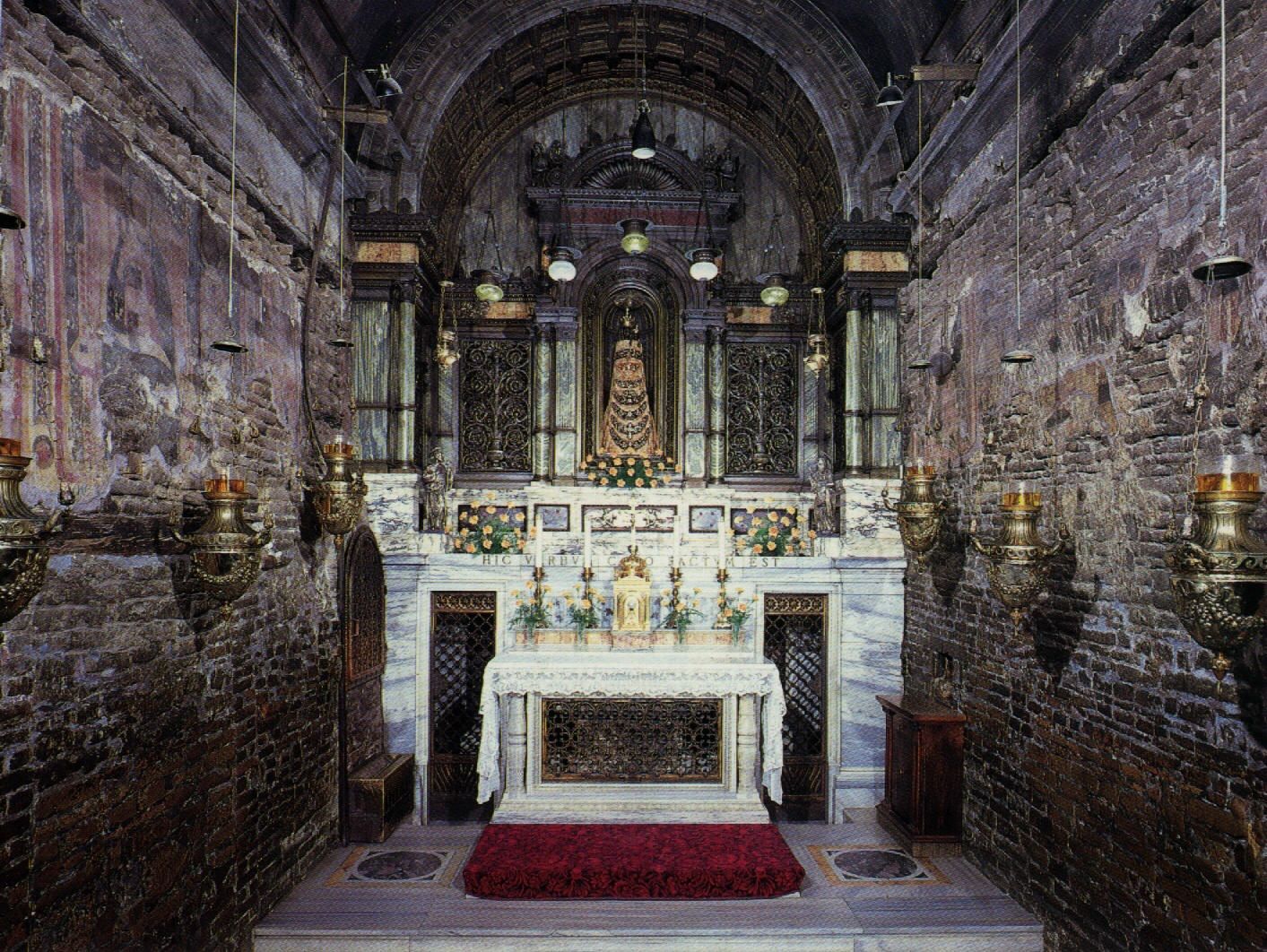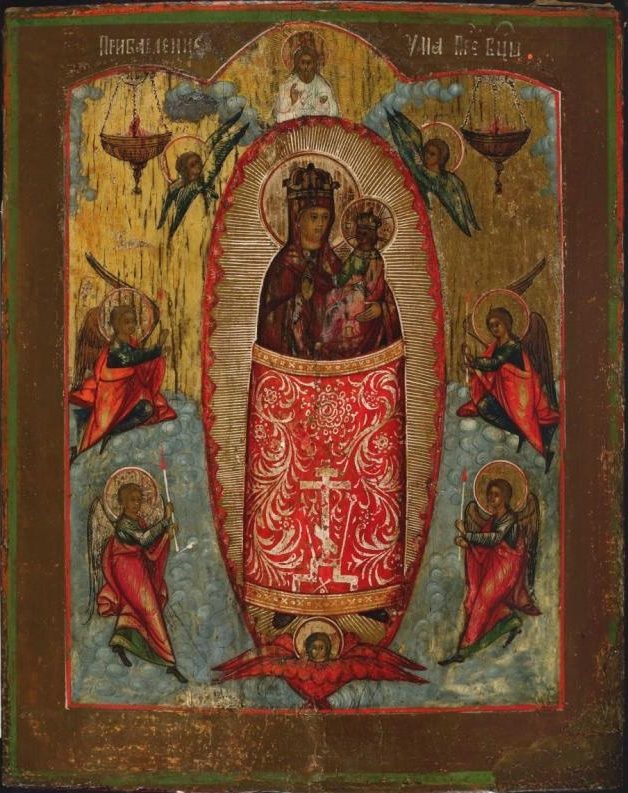On this Sunday after the feast of the Dormition, we celebrate the icon of the Mother of God «Прибавление ума», known in English variously as the “Addition of Mind”, the “Giver (or Increase) of Reason”, or the “Giver of Understanding”, and even a cursory glance makes it obvious that this is a very unusual icon with an unusual history.

But, despite its mysterious and unusual iconography, and western Christian inspiration it is surrounded by great devotion and love.
The other name of this icon “Loretskaya” makes clear its roots in the little town, but great shrine of Loreto, on the Adriatic Coast of Italy, and it is inseparable from the Holy House of Loreto, which the Orthodox Church recognises as the relocated House of the Holy Family, from Nazareth, in which the Mother of God spent her earliest years, to which she returned when she left the Temple and was betrothed to St Joseph, and in which the Archangel Gabriel announced the news of the Incarnation of the Saviour.
Pious Roman Catholic legend claims that the Holy House was miraculously transported by angels away from Jerusalem, conquered by the Muslims, in 1297, firstly to Dalmatia, and from there, in 1294, the Holy House, along with the image of the Mother of God, traveled to the small port of Ancona, and then to Loreto. However, this story was only first recorded in 1400.
History tells us that the Angels who transported the Holy House were the Despot of Epirus in Greece, whose family name was indeed Angelos.
Having been stored in Thessaly, in central Greece, the stones of the Holy House arrived in Italy as part of a marriage dowry.
Once rebuilt, Loreto and its Holy House became a centre of pilgrimages – visited in 1844, by the Russian pilgrim and Archimandrite Porfiry, who described his impressions wrote down in his diary:
“A magnificent church was built on the very site of the wondrous event (presumed by him to be the translation by the heavenly powers). As soon as you enter it, you will immediately see that sacred cave in which the Archangel announced to the Humble One about the incarnation of the Son of God in Her. This cave was within the house and probably made up the lower level of it, where the Mother of God was engaged in handicrafts and divine contemplation. It is remarkable that even today the Nazarene women work in the lower parts of the house, and only rest in the upper room at night. It is also remarkable that even today in some houses there are caves or, better, houses attached to caves. I saw one such house in passing in the upper part of the city. It’s no wonder that Joseph’s house was attached to a natural cave, where there was a workroom and a kitchen.”

It was such a visit, but three centuries earlier that saw the arrival of the prototype of the Pribavlenie Uma icon in Russia, the Russian Great Prince Ivan III, having looked to western Europe for alliances and trade, as well as considering the implications of the Council of Florence.
In 1524, at the invitation of Pope Clement VII, a Russian embassy visited Italy, and the Pope organised an excursion to the Holy House of Loreto hoping to win over the solidly Orthodox delegation. The ambassadors Yeremey Trusov and Dmitri Gerasimov were touched and impressed by by the translated shrine from Nazareth; and related the story and news of the Holy House to Great Prince Vasily on their return. By this time, any icon which had belonged to the the Holy House in its original location were lost, but a carved rendering of the image of the Mother of God we see in the icon was enshrined above the altar of the Holy House.
In Russia, the carved image of the Mother of God was translated into Orthodox iconography, preserving specific features of the Holy House, including the niche above the altar and the hanging lamps, with a town – representing Loreto – beneath the feet of the Mother of God and Christ-Child, both wrapped in an ornate phelonion and crowned with diadems. This image proved popular and became wide-spread.
In 1547, at the time of the Great Fire of Moscow, which destroyed much of the old wooden city, we know an icon of the Mother of God of Loreto was painted “in the Moscow manner”.
A legend from the next century tells of a pious icon painter who suddenly became interested in the book corrections and reforms of Patriarch Nikon, and in spiritual confusion he could not understand whether Patriarch Nikon’s faith was true, or that of the Old Believers.
Such was his confusion that the man went mad, but between fits of madness he was able to pray the Holy Mother of God for forgiveness and the return of a sound mind. The Holy Mother of God appeared to the icon painter several times, and he painted her icon and received healing of his mental state, calling the icon the “Addition of Mind”. Interestingly the story does not tell us whether his conclusion was that the corrected books and reforms were his choice, or the Old Ritual – though presumably the reformed books, given the late and foreign roots of the icon!
In the centuries since then, principally the 18th and 19th, when the vast majority of the copies of this icon were painted, this holy image of the Mother of God has been associated with the healing of mental afflictions as well as more general illnesses, and with help in learning and mental disability, demonstrating how Orthodox Christianity has been able to be open and inclusive, discovering a truly Orthodox understanding, sacred iconography and spiritual meaning of a devotion that originated outside the traditional Orthodox heartlands, though rooted in the very place of the Annunciation.

The ambassadors to Pope Clement remained unshaken and uncompromised in their Orthodox Faith, and precisely because of their immovability and fearlessness, they were able to appreciate the humble greatness and sacred significance of the house of Galilean limestone, which they entered in Loreto and venerated, far from its original home in Nazareth. Their awe and devotion, and the depth of their impressions, related to the court in Moscow, lie behind the great and precious icon which we honour today.
Despite the Holy House being the place of the Annunciation, we celebrate this icon during the afterfeast of the Dormition, the time of the glorification of the Mother of God in heaven.
When we look at the icon, we see that despite holding the Infant-Saviour, the Mother of God is very much portrayed as the glorious and glorified Queen of Heaven, robed and crowned in royal splendour: the crown of creation and the token of humanity, risen, glorified and welcomed into heaven.
Most Holy Mother of God, our Heavenly Queen, pray to God for us!

Тропарь, глас 4: О, Пресла́вная Ма́ти Христа́ Бо́га на́шего, благи́х Пода́теля, * ми́лостию Свое́ю всю вселе́нную сохрани́, * да́руй нам, рабо́м Твои́м, прему́дрость и ра́зум, * све́том Сы́на Твоего́ ду́ши на́ша просвети́, * еди́на Всепе́тая, от Херуви́м и Серафи́м сла́вимая.
Troparion, tone 4: O most glorious Mother of Christ, our God, who art the Giver of all good, * preserve the universe by thy mercy; * give us, thy servants, wisdom and reason; * enlighten our souls with the light of thy Son, * |O thou only all-praised one, who art glorified by the cherubim and the seraphim.